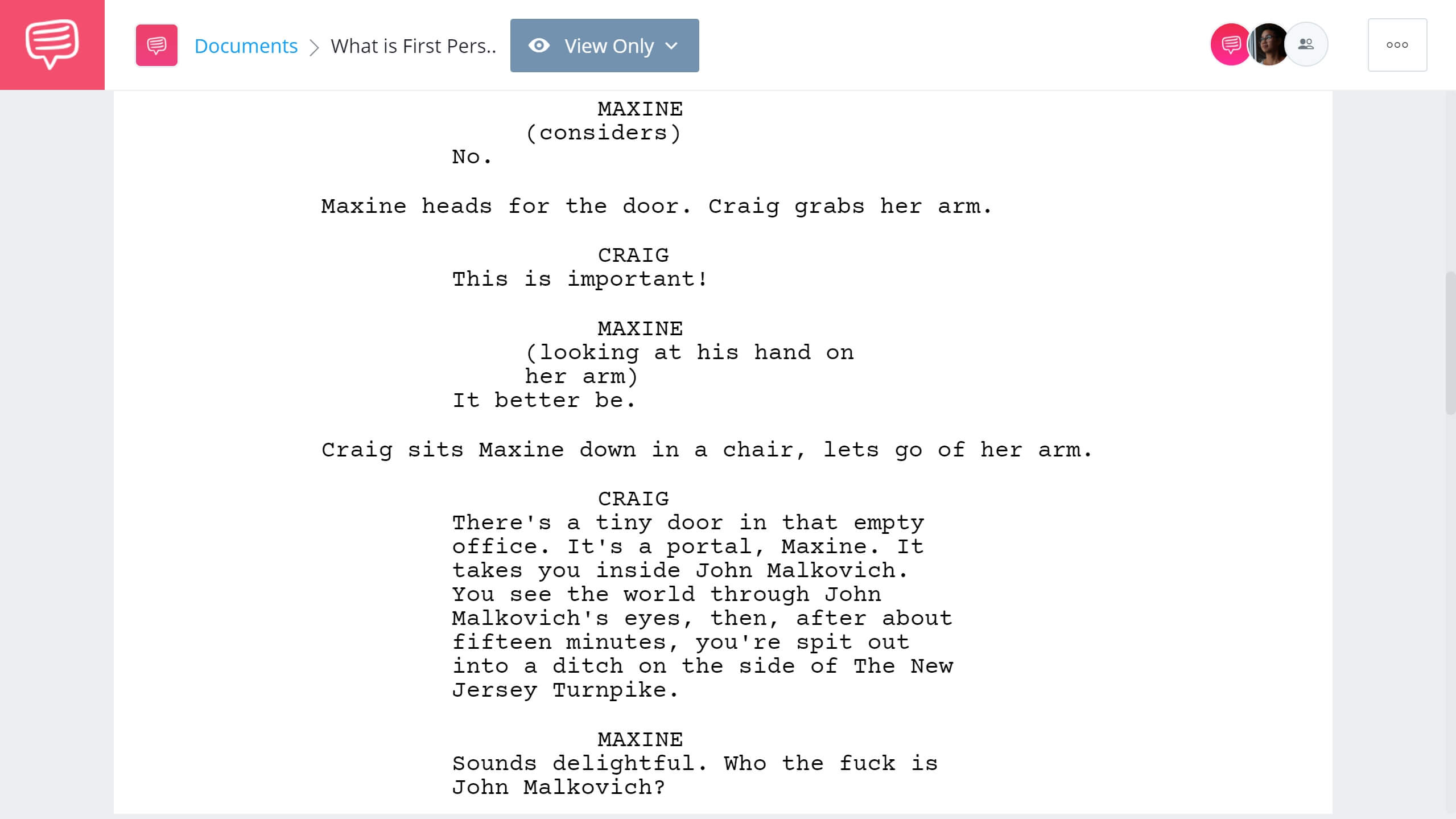I, me, we, and us, are all words used to articulate ourselves in the first person point of view – but what is first person point of view? We’re going to explore how the first person point of view, or POV, is used in prose, poetry, cinema, and video games as both a writing and framing technique. But before we dive into our examples, let’s review what makes the first person POV, the first person POV.
1st Person Point of View Explained
What is 1st person point of view?
There are a lot of different ways to articulate yourself in the first person, some singular, some plural. It’s important to maintain grammatical consistency in first person writing, so that we as the readers know which characters are being referenced. We’ll get to some first person POV examples in a bit, but first let’s define point of view!
FIRST PERSON POINT OF VIEW DEFINITION
What is first person point of view?
A first person point of view is a character perspective that’s used to relay the thoughts and feelings of a character or entity within a story. First person is defined by the use of I, me, we, us, etc. In video games and movies, the term “first person point of view” is used in reference to the perspective of the camera. For instance, the “first person shooter” is a video game genre in which the player controls a character (shooter) from their vantage point.
First Person Point of View Characteristics
- Offers insight to alternate views
- Focus on internal thoughts and feelings of a character
- Creates intimacy between the piece of work and reader/viewer/player
What’s First Person Point of View in Grammar?
1st person POV examples in grammar
Now that we’ve reviewed the first person point of view definition, let’s move on to some first person point of view examples in grammar. Here are some first person point of view examples in the singular:
- I
- Me
- My (possessive)
- Mine (possessive)
And in the plural:
- Us
- We
- Our (possessive)
- Ours (possessive)
Every language has its own intricacies. Fortunately, first, second and third person point of view in English is much easier to communicate than it is in other languages. That’s because English doesn’t tie the predicate to the tense and “gender” of verbs like other languages.
For example, in English, if we wish to describe a plan to purchase something, we’ll say, “I will buy” or “I’ll buy,” with the I always preceding the tense and verb. In Italian, the point of view is conjugated into the tense and verb, so the same statement “I will buy” is translated into a single word: comprero.
What Does First Person Point of View Mean in Writing?
First person point of view in writing
How do we explain what we did today? How we felt? Where we went? We express ourselves constantly in the first person. Everytime we say, I did this, I feel that, or I went here, we’re using 1st person point of view. By me writing the actionable we, rather than the hypothetical you, I’m choosing to use the first person rather than the second person.
Our default, reactionary perspective is first person – so it makes sense that first person comes most natural to many writers. Think about a story you like to tell. If you were to put it to pen and paper, how would it look? Well, there would probably be a lot of I, me, we, us, and our. This next video explores in further detail how writers use the first person POV.
What is 1st Person Point of View? • All About Writing in First Person
As storytellers, we’re naturally inclined to tell our stories in first person. As such, narrative essays, short stories, lectures, and blog posts, are all most commonly relayed in the 1st person POV. Some writers make a conscious decision to write in first person while others subconsciously do it because it feels natural.
For creative writing, there’s no “right or wrong” choice of perspective, just be mindful that each contains its own strengths and weaknesses. If you’re a fiction writer looking to subvert the expectations of your reader, consider using an unreliable narrator.
And always be mindful of the difference between first person limited point of view and first person omniscient point of view.
1st person limited point of view is when a story is told from the first person perspective by a narrator who has limited knowledge.
1st person omniscient point of view is when a story is told from the first person perspective by a narrator who has omniscient (all-knowing) knowledge.
Related Posts
First Person Point of View Movies Explained
First person point of view in movies
There are a myriad of different types of camera shots that cinematographers and directors use to uniquely frame their movies – the point of view shot is certainly one of the most audacious. The point of view shot, more commonly referred to as the POV shot, places the camera in a position so that the frame shows what a character or inanimate object sees.
Let’s take a look at a video essay that shows how some of the best POV shots of all time were constructed:
What is First Person Point of View? • Subscribe on YouTube
Some POV shots last just a few frames while others last the entire length of the movie. There aren’t many films that were shot entirely, or even mostly in the first person POV, but there are a few; most notably, The Blair Witch Project, Cloverfield, and Hardcore Henry.
How do screenwriters communicate this perspective in movies? Well, one way is through dialogue. Charlie Kaufman’s Being John Malkovich cleverly places its protagonist inside the body of the title character.
First Person Point of View Movies • Being John Malkovich Except
Here, Kaufman uses dialogue to allow his character to express how it feels to “see the world through John Malkovich’s eyes.” Essentially, it’s a supernatural instance of turning the 3rd person POV into the 1st person POV.
Related Posts
1st Person POV in Video Games
First person point of view in games
The 1st person perspective is also used in video games as a technique to put the player behind the eyes of a character. The best selling video game of all-time, Minecraft, defaults to this perspective, as do the Call of Duty and Elder Scrolls games.
Some experimental games, which are widely regarded as “walking simulators,” use the first person alongside the use of a third person narrator to bend perspective, and subvert our perception of what interactive stories can be.
Two such games are The Stanley Parable and The Beginner’s Guide, both designed by writer/director Davey Wreden. This next video examines how interactive storytelling is changing the game for how POV works in gaming.
What is First Person Point of View? • Philosophy of The Stanley Parable and The Beginner’s Guide
The Stanley Parable and The Beginner’s Guide aren’t the only games to challenge our view of first person. Some other games include: The Unfinished Swan, The Return of the Obra Dinn, Gone Home, Firewatch, and Jazzpunk.
Due to the burgeoning adoption of virtual reality and augmented reality machines, it seems almost certain that our perception of what POV is capable of will continue to change over the next few years.
Related Posts
UP NEXT
Dive deeper into point of view
In this article, we focused only one type of POV – but what about other points of view? Up next, we break down all the basic ideas behind point of view, with examples from literature, movies, and games. By the end, you’ll know how to recognize first, second, and third person point of view.
Up Next: POV explained →
Showcase your vision with elegant shot lists and storyboards.
Create robust and customizable shot lists. Upload images to make storyboards and slideshows.

